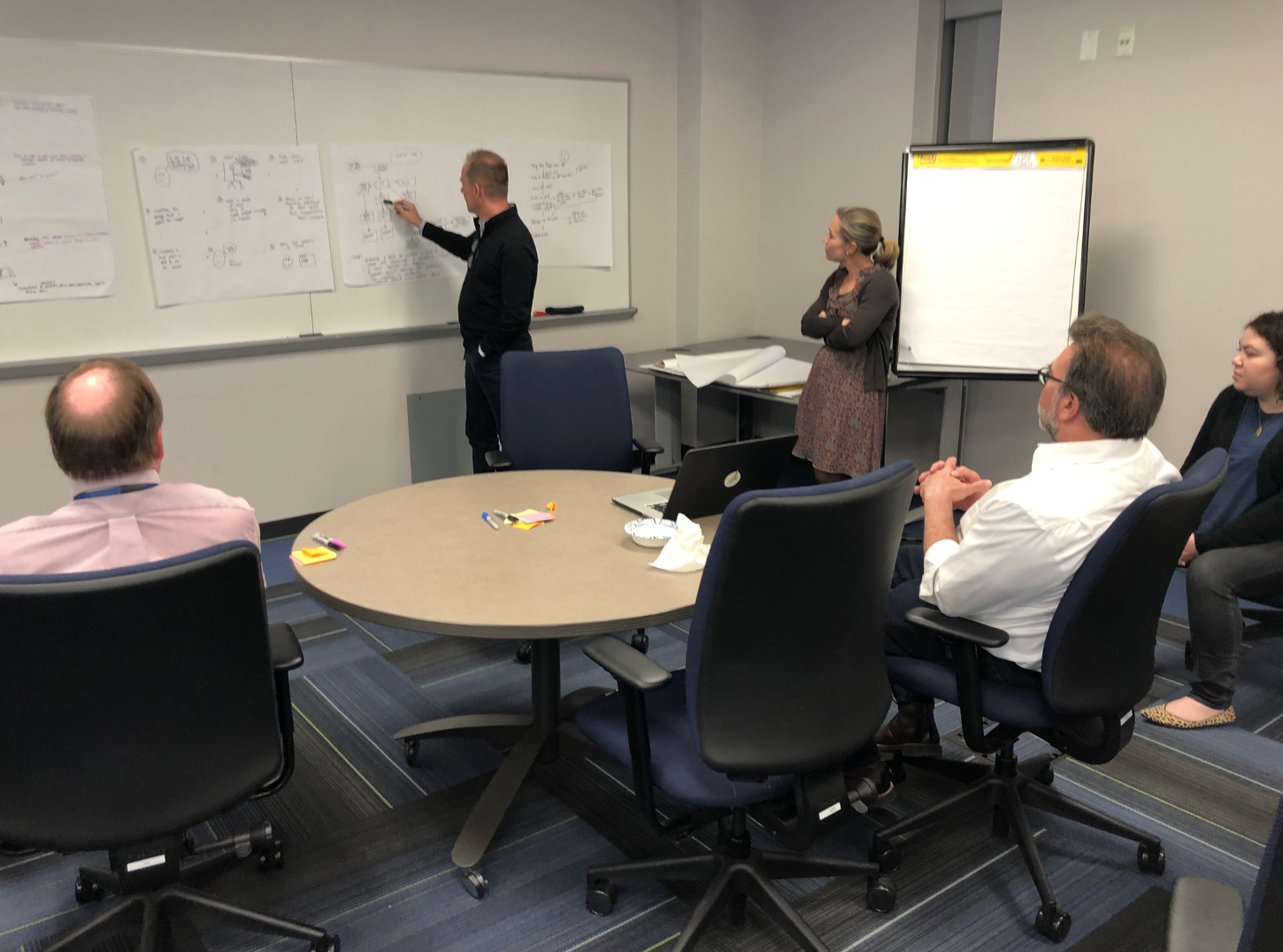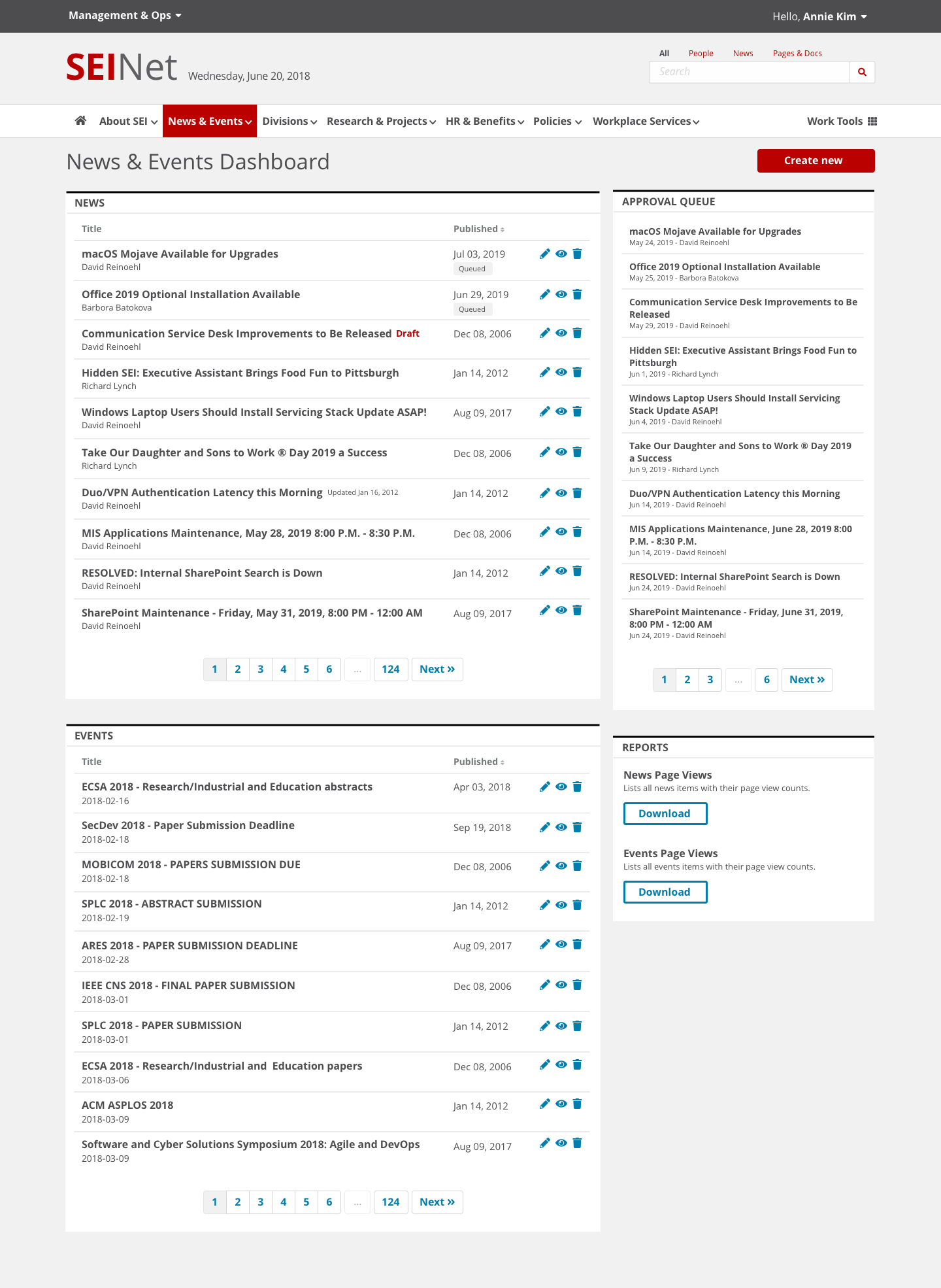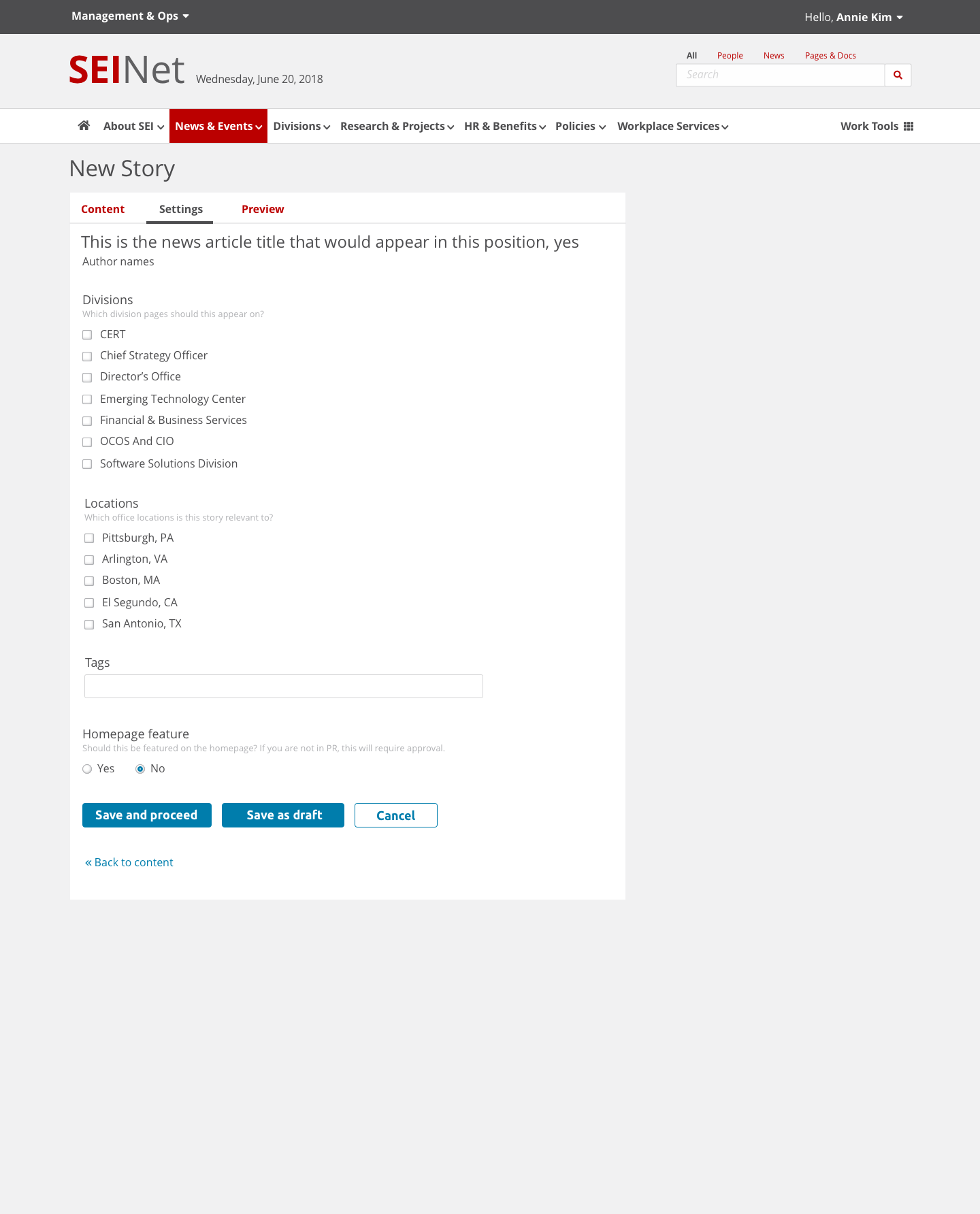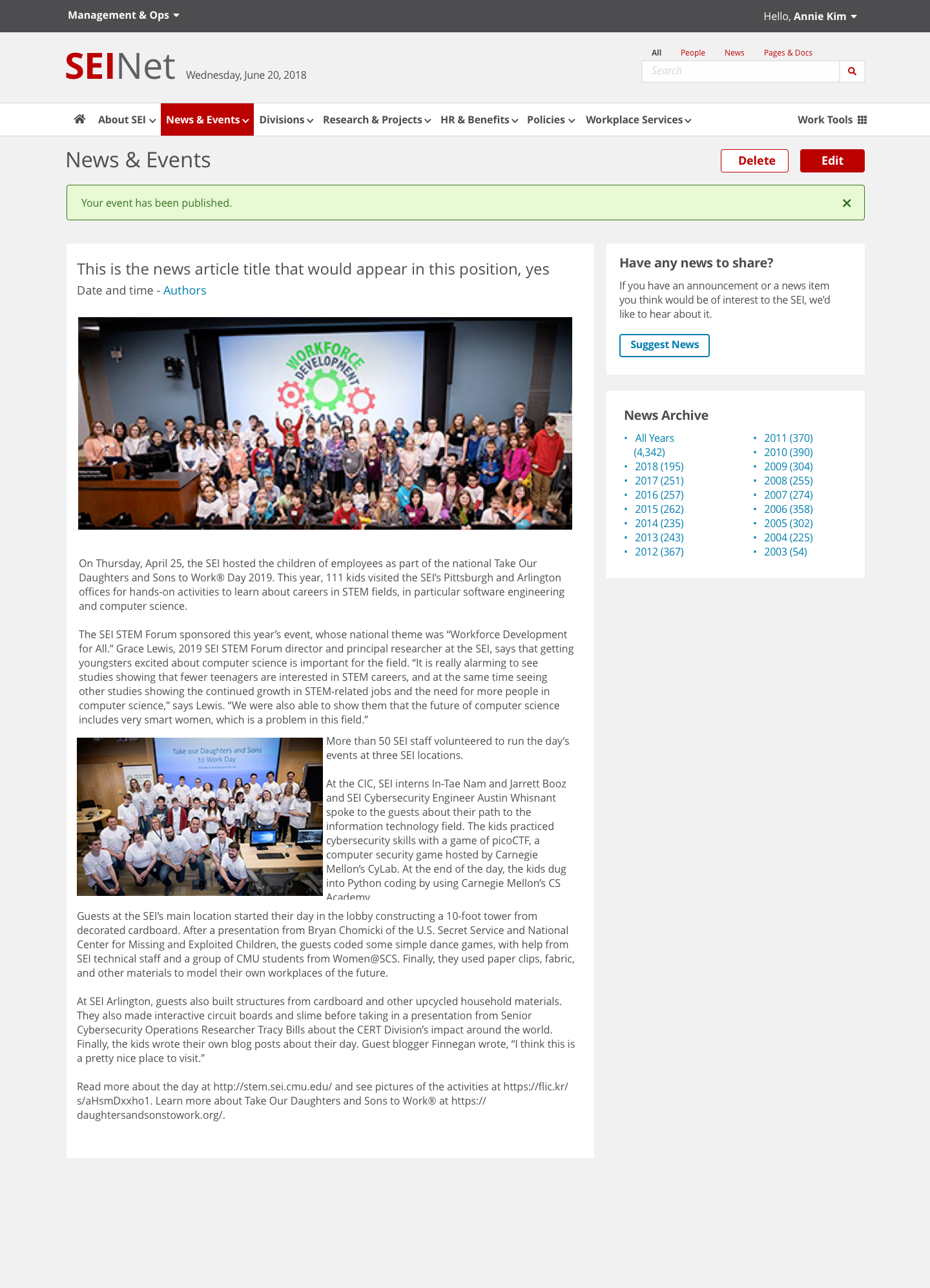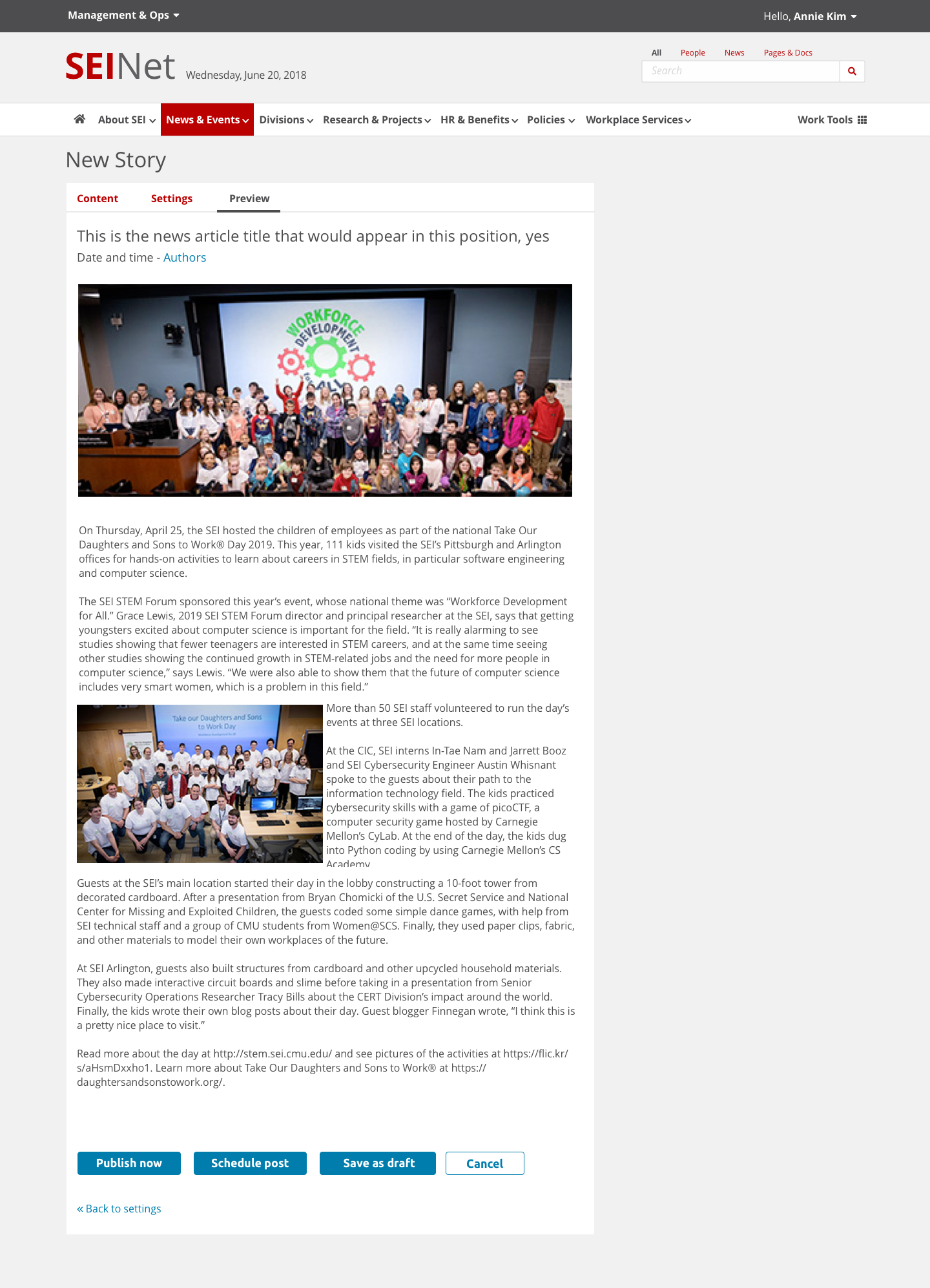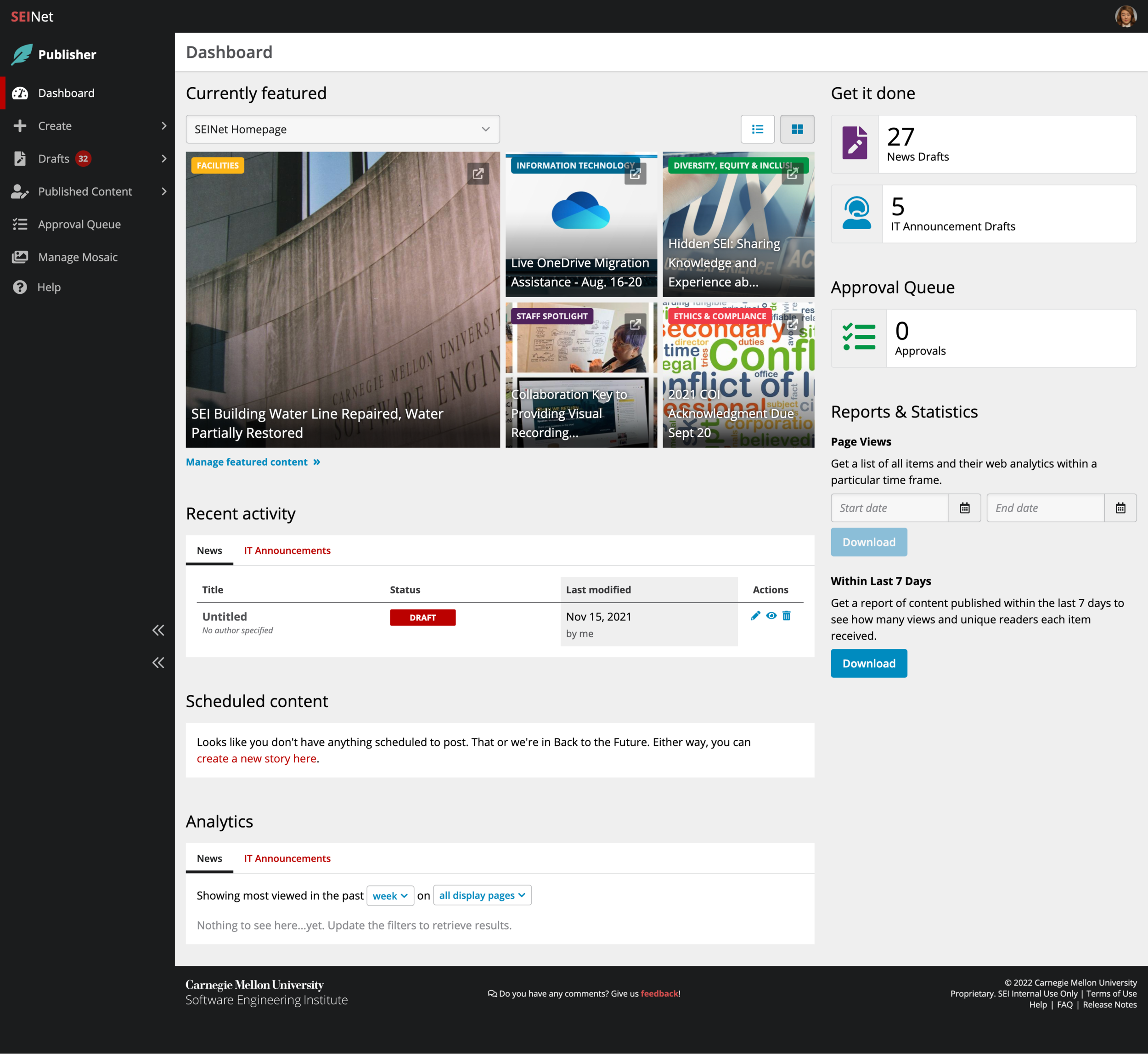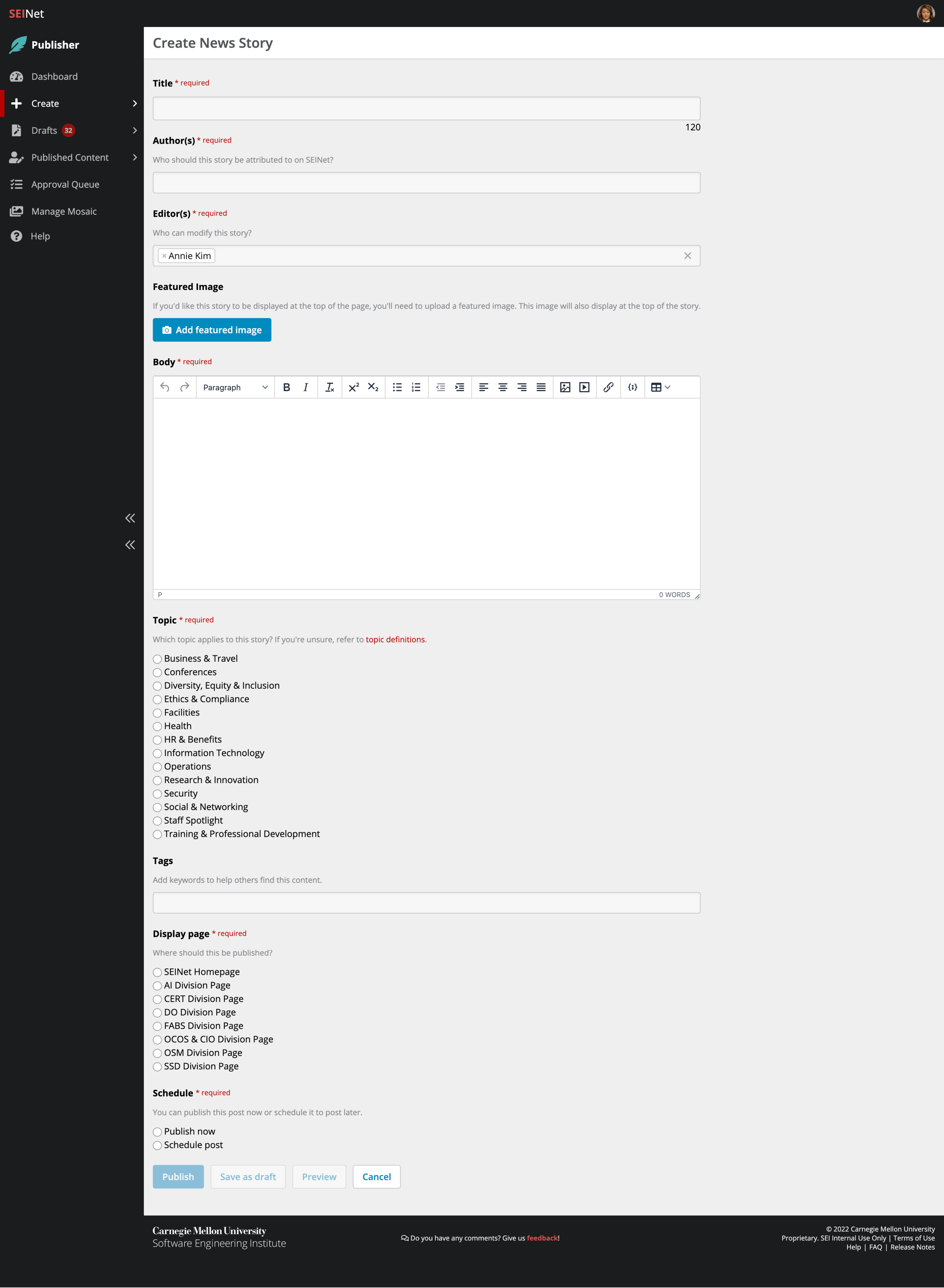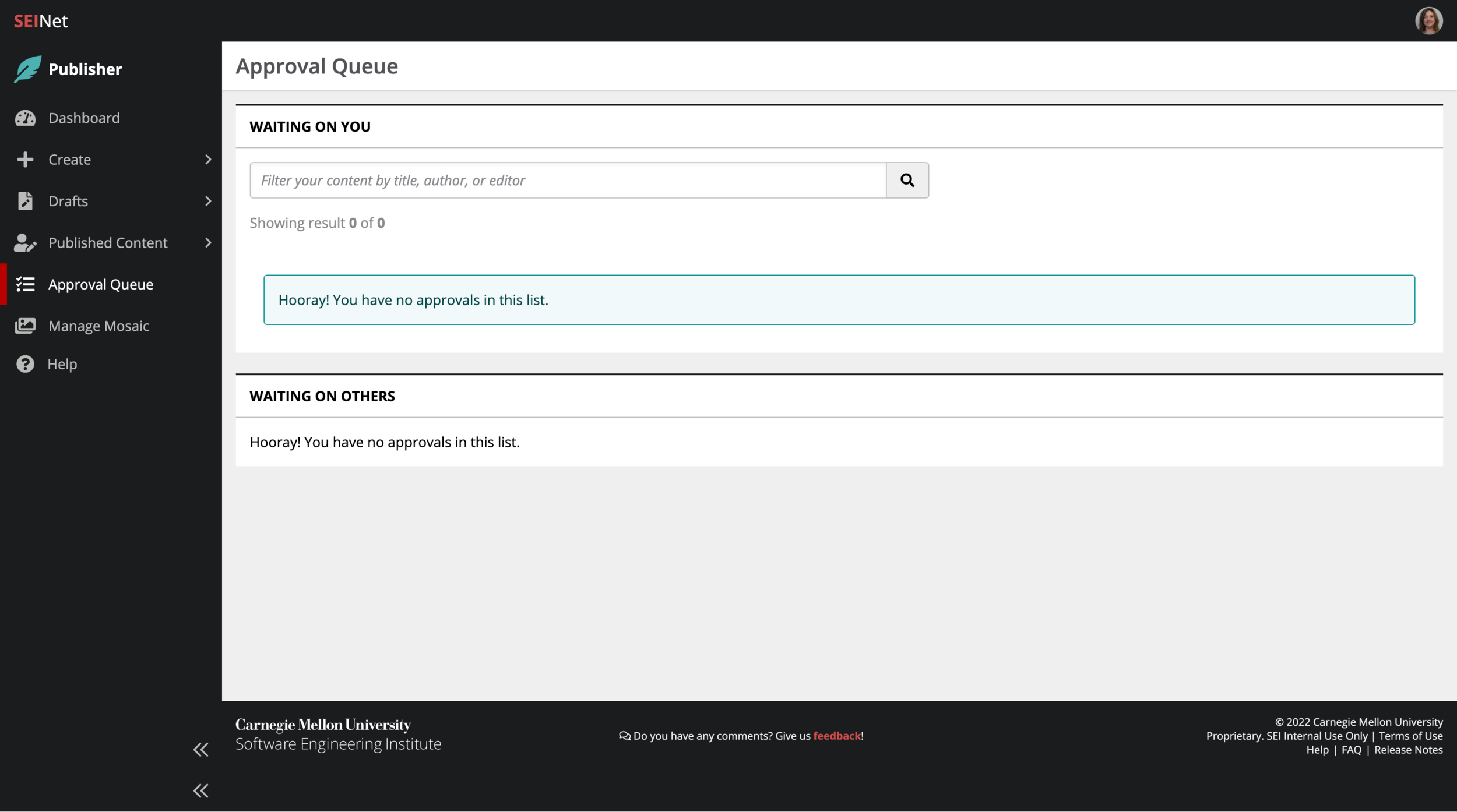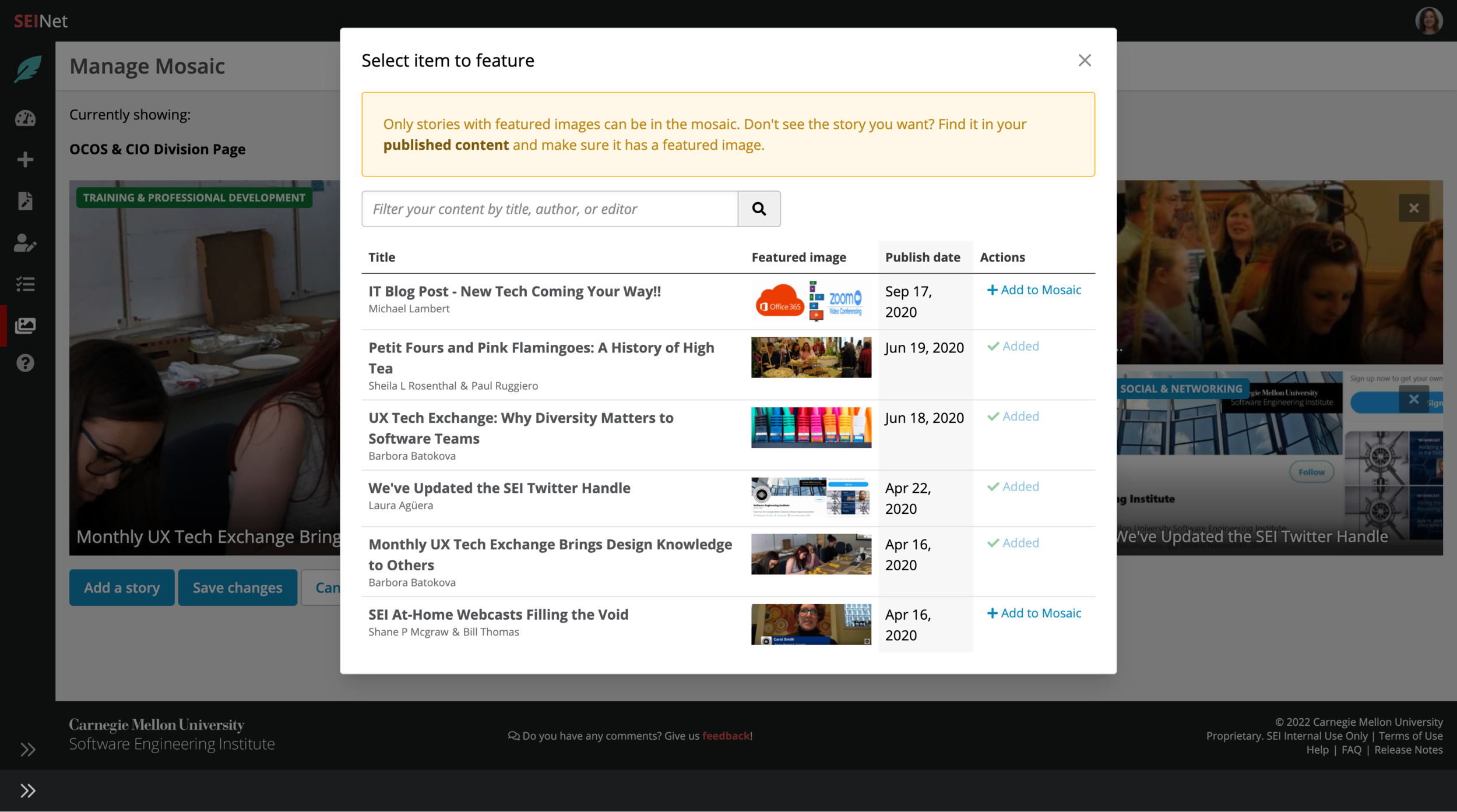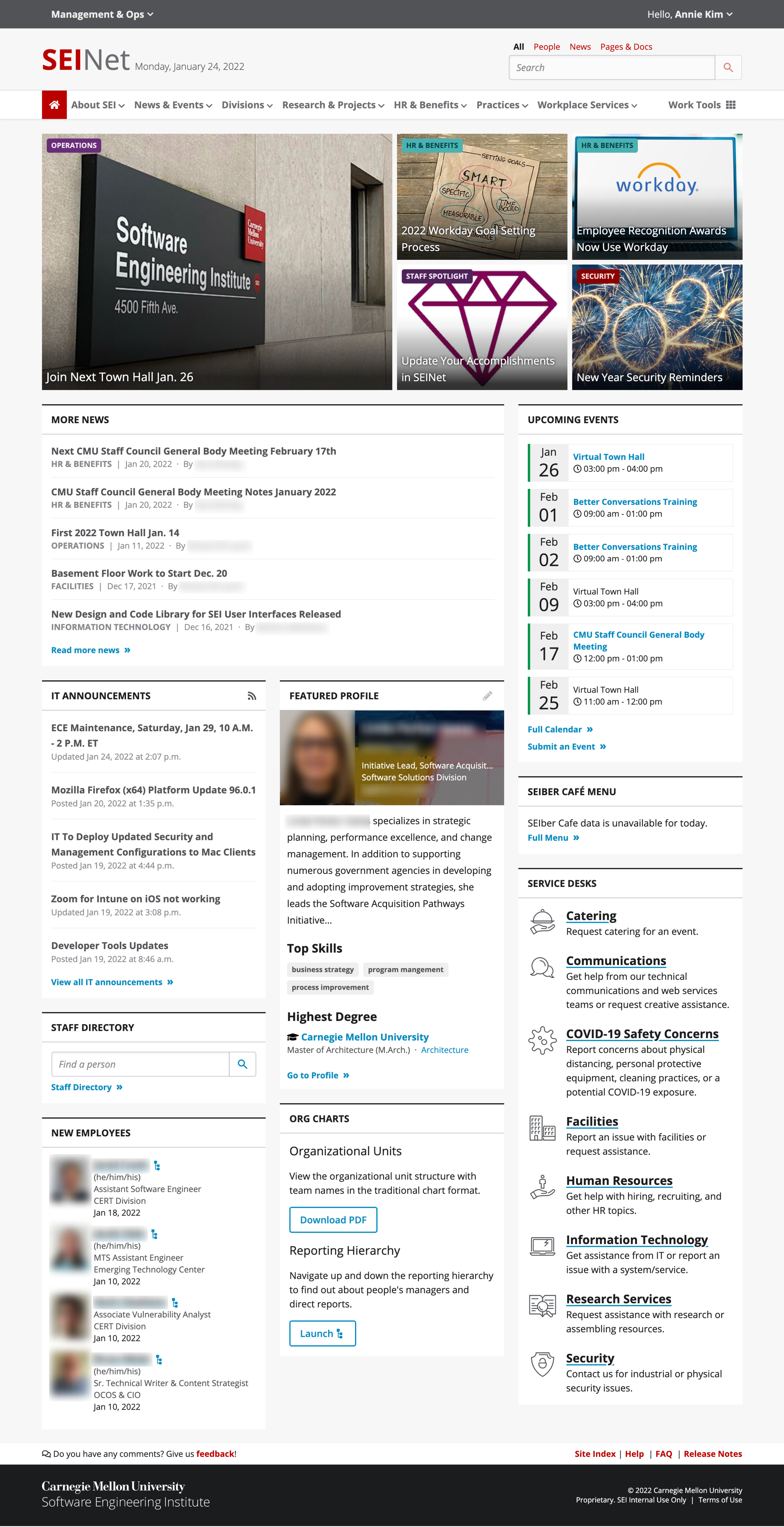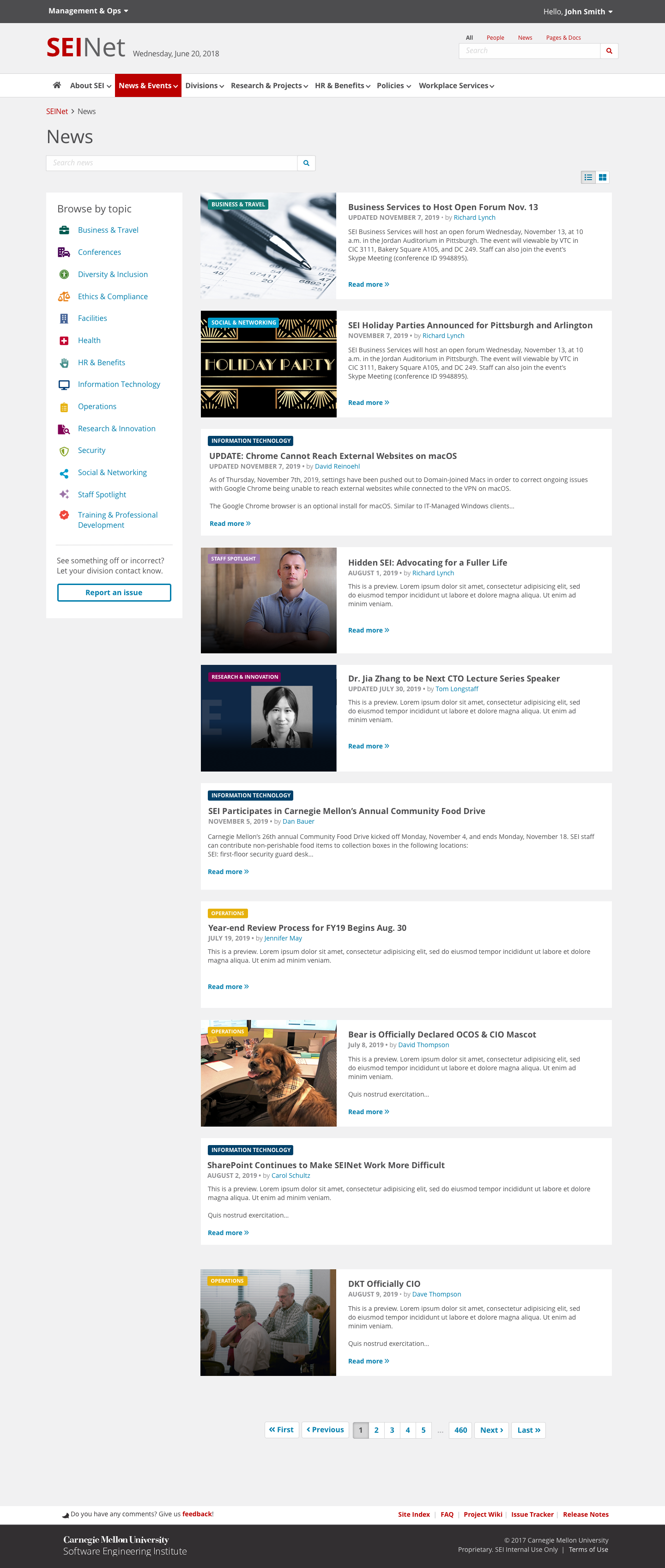A New and Improved News Experience
Improving organizational engagement with rethinking and redesigning internal news.
TIME FRAME: 9 months | TEAM SIZE: 9 members | ROLE: UX Lead/Product Designer
BACKGROUND
In preparation for the Division Pages launch on SEINet, we would like to propose the adoption of a decentralized content model that many winning intranets have in place. Here's a short summary and takeaway from the NNG Winning Intranets 2018:
Corporate Communications and other CEO-sanctioned communications continue to run the official corporate news sections, but intranet managers often take on a decentralized content model, turning to others across the organization for diverse content.
Distributed content means inclusive content and a rich tapestry of intranet offerings. It also means working with writers who are not necessarily trained in writing, let alone digital content writing, and whose main job at the organization is not to create intranet content.
The best intranet teams offer thorough, creative support for content publishers, including their own section on the intranet or other support systems to help them deliver the best possible content. Training sessions on writing and cyber security, a library of training materials, guidelines and standards, and an open dialogue with communicators and content owners combine to create a potpourri of content confidence.
My Role
I was the lead product designer for what we now call SEINet News+. I conducted everything from initial user research and secondary research to UI design and collaboration with our developers through implementation.
DISCOVERY
Initial Considerations and Requirements
Calendar and news systems must be able to see each other and be pulled into one stream - e.g. a rotator, and be associated with each other if we need both an event page and an announcement.
We must begin to differentiate between news, announcements/updates and events — and possibly internal campaigns — i.e. announcements about events.
What if we allowed people to customize their newsfeed on the homepage?
Begin to attribute news stories to authors to create accountability and ownership.
The Issues
Based on feedback from our users over time, our team identified recurring issues:
Cluttered and uninviting
Irrelevant or missing content
Decentralized and competing news sections - (homepage, team page news, etc.)
Difficult event creation and management
Understanding the Current Process
Auditing the Legacy Application
The way news was created and published to SEINet was through the News Maintenance Application. The only users who had access were the single developer and two writers from the Public Relations team.
In order to understand how the application and publication worked, I interviewed those who had access to the application as well as sat through a demo of the app itself.
Visualizing How Future Stakeholders Understand the Process
I facilitated a structured activity to transform stakeholders' preexisting knowledge and ideas into shared concepts about news and events. Each participant created their own cognitive map — an illustration of how they understand the SEINet news publishing process. This was to set context for any issues and identify disconnect between stakeholders.
Mapping the Interactions and Identifying Pain Points
Based on my discussions with current writers and stakeholders, I mapped out the interactions and identified points of friction in the publishing process.
Expanding Our Reach
So far our research was limited to people who were already familiar with the process and those who have been interested. We needed to gather feedback and qualitative data from technical staff members who weren’t in constant communication with us. This would help generate ideas and provide direction for changes and new features for news and events on SEINet.
I interviewed 6 technical staff members, each interview lasting approximately 20-30 minutes in the interviewee's office. Based on these interviews, I noted these high level insights:
Our current users trust that our content is reliable and of high quality.
Given that SEINet is the SEI's official intranet, users trust that the right people are putting in the right information.
Frequent, or power users, also know where to find content they need and that it will be accurate (and if not, they know to tell our team).
But many staff members are not aware of what content is available on SEINet.
Some don't check SEINet on a regular basis which means they don't see any news, or are aware of any new features and improvements
One user was not aware of division pages, despite a news announcement and feature on the rotator.
If someone isn't checking the site daily, then they miss out on important news and announcements.
We're also aware of the learned behavior of going directly to the Site Index, instead of discovering new features.
Users are not getting the news or updates they need from SEINet.
Announcements and news often get lost in the noise (see above).
Many relevant external news or achievements are not acknowledged on SEINet.
Important and often time-sensitive information that technical staff would benefit from is not announced.
Staff members want to feel more engaged with the rest of the institution.
All of our interviewees mentioned how top-down and bottom-up communication can always improve.
They also noted the lack of communication between divisions, and even teams within divisions.
People are willing to contribute content themselves, and spark discussion on one central platform.
While people aren't forthcoming about their own achievements, they're willing to talk or write about their peers' achievements.
IDEATION




Mapping Future Interactions: AEIOU
I organized a meeting with the current stakeholders to use the organizational framework AEIOU: Activities, Environments, Interactions, Objects, and Users. This was to brainstorm what might be involved in getting news onto SEINet.





Participatory Visualization
I gathered several technical staff members to generate many wide-ranging ideas in a short amount of time with a creative matrix and letting each person develop an idea through a concept poster.
The structure of a creative matrix is useful because it stimulates cross-pollination by providing a template for generating new ideas where topics intersect. Concept posters can promote a vision of the future, help build a business case, gain support from decision makers, and provide a road map for moving forward.
Inspiration from the Best
In addition to the decentralized content authoring model and potential new application, we knew that our internal company news portal would also need a revamp. I took a look at the online newsrooms of some of the most prominent tech companies out there as inspiration. The newsrooms I looked at were from Adobe, Apple, Atlassian, Cisco, Facebook, IBM, Intel, Microsoft, Netflix, Oracle, Salesforce, Samsung, Twitter, Uber, and Workday.
DETERMINING MVP













Buy a Feature
This method involves giving potential features a price and asking people to “buy” the most valuable ideas, listening carefully to the decisions and comments they make along the way.
It's based on a system of constraints that create tension by offering choices that exceed available resources. It aims to simulate the conditions that exist when people have to budget their resources to get what they truly desire. Participants can be asked questions about why they make certain choices. Those answers may be just as meaningful as their purchases.
Potential features will be on individual cards, priced at $100, $200, $300, or $400. Everyone will get $1400 to spend on these features. Each person can also write up to 3 of their own features (write-ins are priced at $400).
Cards can be organized, eliminated, or written on as participants see fit. Participants also don't have to spend all their money.






Importance/Difficulty Matrix
As a group, we ranked each feature by relative importance or impact along the bottom of the chart — left is least important, right being most important.
Keeping the horizontal position, the sticky notes can then be moved vertically by relative difficulty. “High value” or “High return on investment” ideas are in the bottom right quadrant. “Strategic” ideas fall in the upper right. Compared to the other ideas, these are the moonshots. “Targeted” or “low-hanging fruit” ideas are in the lower left. These are often quick wins. “Luxurious” or “low return on investment” ideas are in the upper left quadrant.
Drumroll…The Decentralized Model
Based on all my investigation and analysis, our team determined three levels of stakeholders to contribute content to SEINet:
Organizational oversight by Public Relations (2 roles)
Divisional oversight by Content Managers (7 roles) who are overseen by Public Relations
Team oversight by Content Authors (30 roles) who are overseen by their respective Content Managers
Each role had specific permissions. For writing organizational news, a.k.a. news that would appear on the SEINet homepage:
For divisional news, a.k.a. news that is relevant to specific divisions within the SEI:
And for promoting content to the SEINet homepage, or highlighting stories by placing them front and center with big ‘ol graphics:
These roles also culminated in an approval workflow (seen on the right — don’t worry, in practice it’s not as intense as it seems).
SKETCHING & PROTOTYPING
Our initial sketches began with our product owner’s request in mind: a simple webpage(s) within our intranet that would allow users to create and publish content. However, as we learned more about our users and the issues that we could help tackle, the single webpages turned into a full-blown application.
From a few basic native web pages…
…to a full application, designed and built for future features on the roadmap
This new application, named SEINet Publisher, incorporates the decentralized content authoring model that allows staff members who are interested in creating content to get it out there. With approval workflows that we determined and negotiated with our organizational writers and PR team, we created an application that was easy enough to use for new writers as well as those who had been using the legacy News Maintenance Application for decades.
And, as mentioned before, with a new content authoring model comes an updated look to how news appears on SEINet.
For reference, prior to News+ the SEINet news section looked like this.
USER DOCUMENTATION
Listen, I know designers don’t usually include any type of user documentation they’ve written as part of their process or portfolios. But for the Publisher application, it was the peak of The Mandalorian’s popularity, and I was going mad while ill in bed. So I went a little crazy with the user documentation on our wiki, from custom CSS to animated gifs of the Child.
Sorry…not sorry,
NEXT STEPS
We built the Publisher application, as well as developed the whole SEINet News+ experience to adapt to future items on our SEINet roadmap. Our vision includes:
Incorporating video and media management
Managing a main organizational calendar
Reconfiguring IT announcements
…and more
Exciting things to come. Stay tuned, and thanks for reading!












